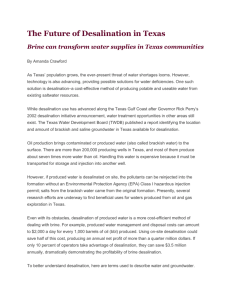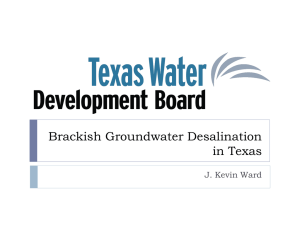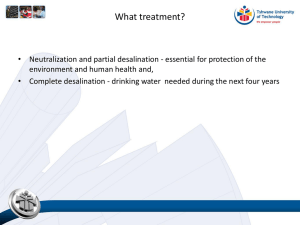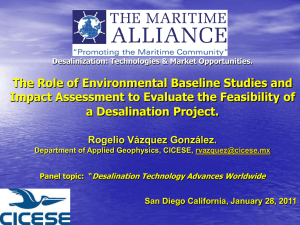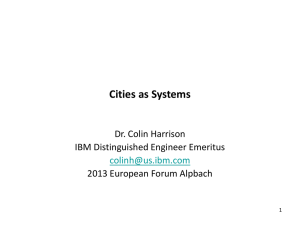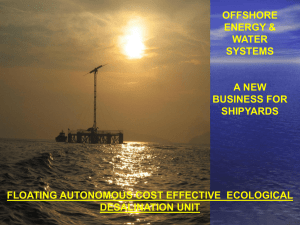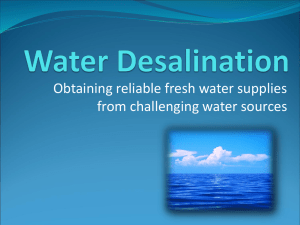slides - Multi-State Salinity Coalition
advertisement
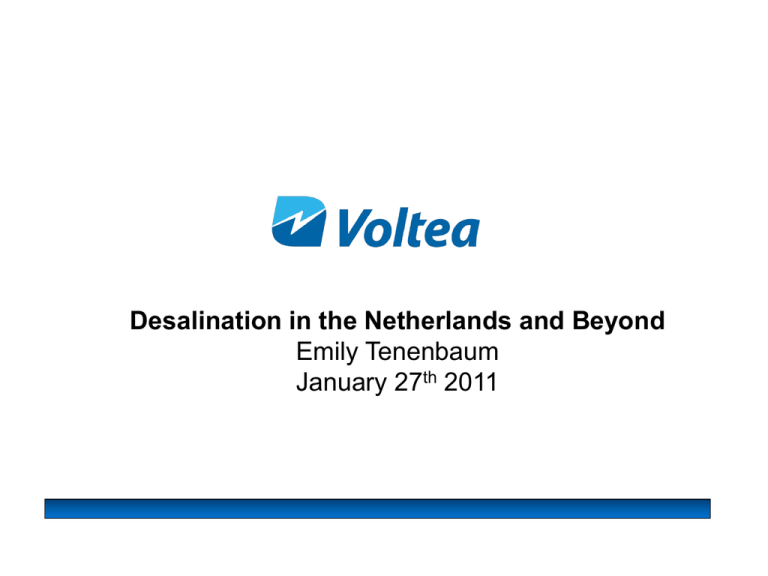
Desalination in the Netherlands and Beyond Emily Tenenbaum January 27th 2011 Outline Intro to Voltea & Capacitive Deionization Overview of Freshwater Scarcity in Europe Freshwater Scarcity in the Netherlands • Desalination for agriculture • Desalination for municipal supply • Desalination for industry Voltea & CapDI Founded 2006, Netherlands-based Spin-off from Unilever Main activity: Develop and Commercialize Capacitive Deionization technology (CapDI) 40 employees, growing rapidly CapDI basics • • • • • • • • Low feedwater pressure Uses ion-exchange membranes Treats tap to brackish water Minimal pretreatment No or little chemical use Low energy use Competitive with RO, EDR, ion exchange Current commercial applications: cooling tower make-up water, residential point-of-entry Water Availability in Europe Desalination Capacity by Country World Resources Institute Water Stress Atlas, 2000 Water Availability in Europe the Netherlands France Significant freshwater scarcity in Northern Europe Belgium Brackish Water in Netherlands Depth of Brackish Water Interface meters below Normal Amsterdam Waterlevel (NAP) to reach [Cl-] = 1000 mg/L Growing Problems: •Coastal saltwater intrusion caused by depletion of fresh groundwater •Inland brackish groundwater Netherlands area = New Jersey + New Hampshire Desalination Needs in the Netherlands 1. Agricultural – saltwater intrusion in greenhouse areas 2. Municipal – increasingly brackish surface and groundwater 3. Industrial – Strong financial incentive to reduce industrial water use. Many solutions require desalination Greenhouses near Rotterdam Tulip field near Voltea HQ Desalination for Agriculture in Westland Depth of Brackish Water Interface meters below Normal Amsterdam Waterlevel (NAP) to reach [Cl-] = 1000 mg/L Westland Region, a.k.a. “Glass City” Desalination for Agriculture in Westland 42% Dutch greenhouse sector ~1% National GDP Brackish surface and groundwater Low-efficiency RO systems treat groundwater for greenhouses Deep injection of brine Upcoming government ban on brine injection Westland Greenhouse Region Desalination for Agriculture in Westland Problem: brackish water challenge for greenhouses Solution: reuse WWTP effluent for greenhouse irrigation Parameter WWTP Effluent Westland Greenhouse Region Harnaschpolder WWTP Greenhouse max level [Cl-] 135 mg/L 36 mg/L [Na+] 100 mg/L 23 mg/L ~75% salt reduction needed Pilot Testing for Wastewater Resuse Long-term pilot testing underway of 3 desalination options: UF/RO (Evides) Innovative RO train (Veolia) CapDI (Voltea) Pilot hall at Harnaschpolder WWTP Harnaschpolder WWTP Voltea engineer testing benchtop CapDI units at WWTP Desal for Municipal Water Source: Oasen Drinkwater Saline water from marine deposit layers and North Sea is seeping into drinking water sources National drinking water chloride limit is 150 mg/L Drinking water providers forsee difficulty in meeting the chloride limit Some drinking water wells already shut down Drinking water providers exploring brackish water desal options All projects still in pilot phase Desal for Municipal Water Voltea Pilot in Rotterdam • • • • • • Voltea Capacitive Deionization System April - Nov 2011 Test CapDI on groundwater Feed conductivity = 1.5 mS/cm 6 L/min (0.36 m3/hr) Oasen drinking water station Results promising! • 80% salt removal • 70% water recovery • 0.4 kWh/m3 pure • Stable operation • Oasen interested in large-scale CapDI system as RO alternative Desal for Municipal Water PURO Pilot • Kickoff 2011 • Place RO system 100 m below ground • Reduced pumping energy • Anerobic process, no iron removal pretreatment needed • Major maintenance challenges with underground operation Schematic of PURO pilot in Ridderkerk Desalination for Industrial Water Regional Water Costs TAPWATER € 3.00 WASTEWATER DISCHARGE € 2.50 € 2.00 € 1.50 € 1.00 Germany USA Netherlands Africa Australia - NZ Asia America's Europe - East Europe - West €- World € 0.50 Dutch tapwater is expensive (€1.75 /m3) Cost incentive for factories to find tapwater alternatives, or reduce tapwater use Desalination for Industrial Water Voltea CapDI in Cooling Towers Rabobank HQ in Utrecht Capacitive Deionization System at Rabobank HQ. ~2 m3/hr capacity Use CapDI to desalinate feedwater to cooling towers Rabobank HQ in Utrecht Increase cycles of recirculation in cooling tower from 3 to 14 17% reduction tapwater use 68% reduction wastewater discharge 75% reduction chemical usage (antiscalents, corrosion inhibitors) Take Home Message Brackish ground and surface water is a growing problem in the Netherlands Problem affects agriculture, drinking water supply, and industry Desal will play a increasing role in the Dutch water industry t Typical view from a window in the Netherlands Desalination for Industrial Water Dow Chemical Plant Section of water plant at Dow Chemical factory in Terneuzen Evides chosen by Dow to design, build, finance, operate (DBFO) industrial water plant Location with limited freshwater Plant produces process water, boiler feed, cooling tower feed, ~3800 m3/hr Demi water initially from seawater RO – major fouling problems (2000-2007 ) 2008 switched to MF/RO fed with municipal wastewater Plan upgrade to membrane bioreactor/RO fed with municipal wastewater NaCl Drinking water limitations Most drinking water is groundwater Dutch National limits on chloride are <150 ppm, Na <120 ppm US secondary DW standard is 250 ppm EU chloride <250 ppm, Na <200 ppm, EC <2500 microS/cm WRI water risk index The 3 dimensions (23 total indicators) of water-related economic risk were determined by WRI in collaboration with industry experts, financial analysts, and water specialists, and include: Access and growth constraints: provides a measure of water risks driven by the physical availability and accessibility of water; Cost risks: capture the cost risks faced by water users due to poor water quality, regulatory uncertainty, or high prices of water and its treatment; and Disruption potential: provides a measure of the tensions and conflicts around water driven by social and regulatory concerns. CapDI – How it Works Desal for Municipal Water Vitens Pilot in Friesland • Vitens-largest drinking water supplier in Netherlands • Anerobic brackish water RO pilot in Friesland (feed = 2.6 mS/cm) • Deep well injection of anerobic brine • No antiscalents due to reinjection restrictions • 70% recovery • Started in 2009 • 50 m3/hr RO equipment in Vitens pilot trailer in Noardburgum, Friesland

